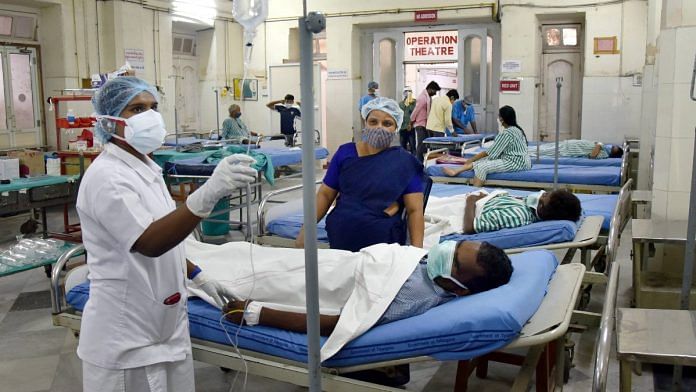New Delhi: The Karnataka government has constituted a committee to investigate possible sources of infection leading to the steep rise in mucormycosis cases in the state, ThePrint has learnt.
The state-level committee, chaired by Rajiv Gandhi University of Health Sciences Vice-Chancellor Dr S. Sacchidanand, will investigate oxygen supply chains, the role of medication (including steroids), and referral cases from smaller hospitals to try and ascertain the source causing cases of mucormycosis in recovering Covid patients.
The panel was formed this week following a presentation by skull surgeon Dr Sampath Chandra Prasad Rao to the government Monday, where he suggested sources of contamination and causes for the surge in mucormycosis cases.
Mucormycosis is a rare disease caused by the fungus mucor. Mucor is found in abundance in the environment, and those with a compromised immune system are most susceptible to infection. It mostly affects the sinuses and lungs, with symptoms including pain and redness around eyes and nose, fever, headache, coughing and shortness of breath
Karnataka has registered 446 cases of mucormycosis so far, which resulted in 12 deaths. Over 11,000 cases have been registered across the country.
On Wednesday, a meeting with Health Minister K. Sudhakar discussed, among other things, the protocols for the new committee to follow.
“It’s still in the preliminary stages, but the first thing the committee will do is to look into where cases are being referred from. Larger hospitals are not seeing their own patients develop mucormycosis, but cases from smaller hospitals are being referred to them for treatment, so that is one thing to look into,” Dr Sacchidanand told ThePrint.
“We should also think of the possibility of diabetes, steroid overuse, and oxygen equipment,” he added.
Also read: At Agra mental health institute, no one forgets to wear mask — even patients with dementia
Beyond steroids
To be sure, the doctors and experts are not ruling out the role that steroids and uncontrolled sugar levels play in patients presenting with mucormycosis.
“Covid and diabetes predispose a patient to fungal infection, but the question is why only mucor. The overuse of steroids can’t be ruled out, but other sources of contamination should also be looked at,” Dr Rao told ThePrint, adding that there were patient-related, hospital-related, and gaseous-supply related factors that could be contributing factors.
Mucor, which presents itself in the form of blackish patches, thrives in moist environments. When it causes infection, it has mostly been nosocomial, meaning originating in a hospital, Rao said.
“Humidifiers and concentrators should be using distilled or sterile water, but smaller hospitals and people at home might be using tap water, which could make it a source of contamination. The oxygen crisis has also led to nitrogen industry producing oxygen. Nitrogen is conducive to fungal growth, and though the government has released guidelines for the industries, how closely this is being followed is another thing to look at,” Rao said.
“Smaller hospitals rely on oxygen cylinders, and they’re not always kept in the most hygienic conditions, and these should be reviewed too,” he added.
Rao also warned against unhygienic mask use which could encourage fungal growth, such as reusing disposable masks and not washing cloth masks frequently. Other factors, like antibiotic overuse and the role of various Covid strains, should also be looked into, he said.
On tracing sources of contamination, Dr Sacchidanand said samples would be collected from hospitals and other places to check for the presence of mucor.
Also read: Maharashtra quadrupled testing, but rural-urban disparity means it’s still a laggard among states






